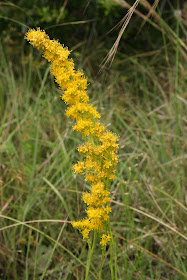Wand goldenrod (Solidago stricta) is another unique species that is relatively easy to identify. Found statewide in Florida in a variety of mesic upland settings and in much of the Southeastern Coastal Plain states, wand goldenrod is difficult to notice until it sends its slender flower stalk upward in late summer. This is a deciduous species. In the spring, it produces a rosette of thin, lanceolate leaves which tend to blend in with the grasses and other wildflowers it occurs with. A single slender flower stalk emerges from this cluster of basal leaves in late summer to early fall. By late fall, it may reach 3 feet in height and the bright yellow flowers open.
Wand goldenrod almost looks like a yellow blazing star (Liatris spp.) when in bloom. The wand of blooms stays compact; rarely do side shoots emerge and give it a wider aspect. This species does not readily sucker, but over time multiple clusters of basal leaves form and each produces a flower stalk.
This is one of the very best goldenrods for the home landscape, yet it is not widely propagated at this time. Because it does not aggressively sucker or get overwhelming in size, it mixes extremely well in a wildflower garden. Its bright blooms provide color and are magnets for pollinating insects. It also is very undemanding in the types of growing conditions it needs. Wand goldenrod will adapt to nearly any landscape condition normally encountered in a residential setting. Don't plant it in inundated soils or the driest xeric sands, and it will prosper. As interest in goldenrods for home landscapes increases due to their color and their exceptional value to pollinators, I suspect this will be one species that becomes much more widely available.




Thanks I enjoyed learning about this one. It does not seem to be indigenous to my area, but I think there are other "wand" goldenrods that I can look for.
ReplyDeleteShould I cut the stalks back after they bloom
ReplyDeleteNo. Spent stalks like these can provide valuable habitat for certain types of bees. The seeds, of course, provide food for various types of birds. /i trim my landscape up in late winter/early spring about the time that I see significant new growth starting.
ReplyDeleteWe routinely carry this species at www.butterflyhabitatrestoration.square.site
ReplyDelete